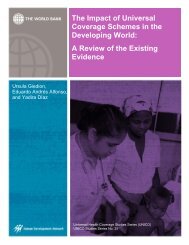11ZAQGM
11ZAQGM
11ZAQGM
Create successful ePaper yourself
Turn your PDF publications into a flip-book with our unique Google optimized e-Paper software.
Impacts<br />
BIODIVERSITY IMPACTS<br />
While the work of the Amsing Association has helped to change<br />
local attitudes and behaviours for more sustainable resource<br />
management, Elmoudaa still faces significant challenges to its natural<br />
environment. A 2011 UNDP/Global Environment Facility (GEF) CBA<br />
project proposal identified threats to the local environment and<br />
biodiversity in three categories: baseline climate and environmental<br />
pressures, anthropogenic factors, and additional threats resulting<br />
from climate change.<br />
As previously noted, these trends have recently been exacerbated by<br />
the effects of climate change, as increased intensity and duration of<br />
droughts and extreme weather events will further degrade already<br />
damaged soils and decrease agricultural output. It was observed<br />
that lower agricultural output may well have led to community<br />
members relying more heavily on forest resources, straining both<br />
biodiversity and land quality.<br />
The report noted that the area’s naturally steep slopes and sandy<br />
soil increase the potential for erosion and land degradation when<br />
combined with less rainfall and erratic extreme weather events.<br />
These conditions had been worsened by various agricultural and<br />
pastoralist practices, however. Excessive terracing (to create new<br />
farmland) had contributed to increased erosion along slopes and<br />
strained local natural water resources for irrigation uses. Hillsides<br />
were also commonly used for grazing of livestock, further reducing<br />
biodiversity and exacerbating these pressures. Planting of non-native<br />
crops, and particularly cash crops with high water consumption<br />
properties, had impacted on native vegetation growth and severely<br />
degraded the soil in areas.<br />
The report also describes how previous wood collection and<br />
deforestation efforts had dramatically reduced biodiversity in<br />
both native vegetation and mammals. As a result, all communities<br />
in the vicinity of Toubkal National Park are prohibited to harvest<br />
forest resources under threat of financial penalty. Finally, water use<br />
practices contributed to more widespread impacts on the local<br />
ecosystem. The creation of irrigation canals and re-routing of natural<br />
water systems impacted natural river-dependent vegetation and<br />
strained the land in areas where canals are dug. Domestic use of<br />
water, and particularly use of the irrigation stream for laundry and<br />
cleaning, resulted in an inundation of salts and chemicals into the<br />
water, eventually resulting in salinization and degradation of land.<br />
27






